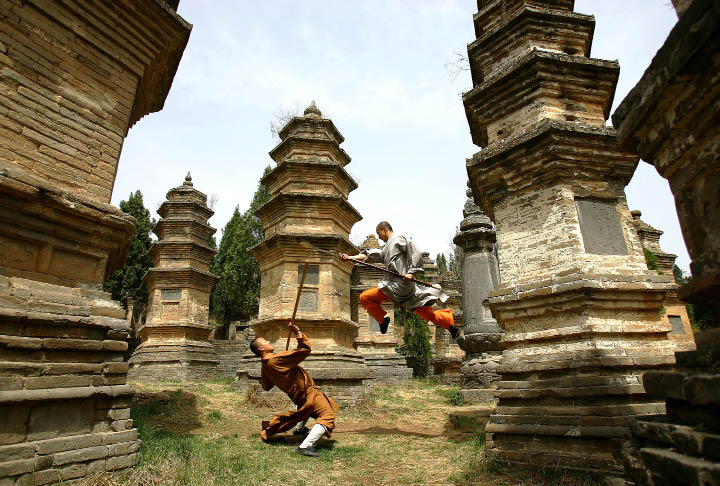| China's World Heritage List Gets Longer
By staff reporter JIAO FENG
 It could be the latest Kungfu flick... but it’s actually martial arts practice in the Shaolin Temple’s Pagoda Forest, made up of the tombs of former abbots.
It could be the latest Kungfu flick... but it’s actually martial arts practice in the Shaolin Temple’s Pagoda Forest, made up of the tombs of former abbots.
AT the 34th World Heritage Committee annual meeting held in Brasilia, two more places in China were added to UNESCO’s World Heritage List – the Historic Monuments of Dengfeng in the “Center of Heaven and Earth” in the cultural category and China’s Danxia Landform in the natural category. This decision brought the tally of world heritage sites in China to 40, including 28 cultural heritage sites, eight natural, and four a combination of the two.
Located in Dengfeng, Henan Province, the “Center of Heaven and Earth” is a cluster of eight monuments encompassing ancient temples, astronomical constructions, educational institutes and carved-stone relics. This collection of ancient buildings and objects, spanning two millennia and seven ancient dynasties, vividly conjures up the history of structures typical of the middle and lower reaches of the Yellow River. Of all China’s ancient construction groupings, this one is seen as having one of the longest chronological spans, the greatest architectural diversity, and richest cultural connotations.
“China’s Danxia” is nominally applied to six Danxia landscapes; taken together they present a panoramic sequence of Danxia Landform through different ages. Inscription onto UNESCO’s list will benefit conservation of this distinct morphology, and signals international acceptance of an ancient Chinese concept.
A Simple Cosmology
The “Center of Heaven and Earth” embodies ancient China’s simple cosmological concept that the world was planar, that China lay at its center, and the heart of China lay in Zhongyuan, namely the Central Plains, along the middle and lower reaches of the Yellow River. Its advantageous geography made this area the chosen location for several early dynastic capitals and constituted something of an enclave. This included Dengfeng. In the eighth century BC, Mount Song, located in Dengfeng, was called “Zhong Yue,” meaning the “Mountain at the Center of Heaven and Earth.” Emperors of past dynasties came here to offer sacrifices; from here ancient astronomers would measure the skies and the earth. Mount Song, along with Mount Tai in the east, Mount Hua in the west, Mount Heng in the north, and Mount Heng in the south, are extolled as “China’s Five Great Mountains, ” objects of mountain worship in ancient China.
|

